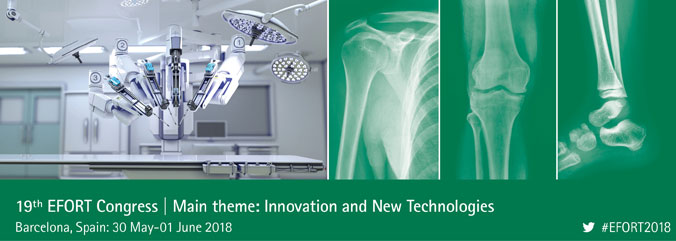Update on intraoperative trauma imaging at 19th EFORT Annual Congress in Barcelona
Click Here to Manage Email Alerts

The main theme of our upcoming 2018 annual meeting, set as Innovation and New Technologies, aims at bringing to the spotlight modern diagnostic techniques, new biomaterials and implants, minimally invasive and computer-assisted surgery, robotics, 3-D printing, telemedicine and patient-specific treatments among others.
Prof. Florian Gebhard, director of the department for orthopaedic trauma at Ulm University, will present an Instructional Lecture entitled “New Advances in Intraoperative Imaging on Trauma,” which will focus on the current status of available visualization techniques during fracture surgery and the increase in opportunities linked to innovative procedures.
In the last few years, so many remarkable developments occurred in the science and technology worlds that improvement is omnipresent in all disciplines. Whether it is the emergence of electric self-driving cars, the standardization of drone transportation or the growth of outer space travel, we are confronted to a huge amount of novelties on a daily basis. This evolution does not stop at the gates of medicine. Surgical innovation is, for instance, witnessed by the entire orthopaedics and trauma community via the availability of new materials and procedures that allow us to overcome the limitations of existing clinical practice.
After decades of relying only on 2-D radiographic techniques to assess injuries and ensure preoperative planning, orthopaedic trauma surgeons can finally benefit from continuous visualization at surgical entry points and during instrument trajectories. Without intraoperative imaging, modern orthopaedic trauma surgery would not be possible. Indeed, the current imaging techniques allow for faster implementation of treatments, safer conditions for patients and a smoother handling framework for health care providers.
New Advances in Intraoperative Imaging in Trauma
Wednesday 30 May 2018 | 10:30-11:00
One of the first important steps in the evolution of surgical imaging was the introduction of rapid and relatively inexpensive computational resources such as CT, which produces 360° cross-sections of the body or limb. However, despite providing key additional details regarding the patient’s bony structure and the injury itself, CT-scans maintain a radiation exposure as the procedure is still based on the X-ray technology. The advent of MRI, based on the combination of a magnetic field and radio waves caused a second swell: detection of occult bone trauma and soft tissue injuries became possible.
Today, new types of implants and the trend to largely use minimally invasive approaches keep enhancing the intraoperative imaging techniques. The invention of flat-panel detectors, which convert X-rays to a charge easily read out, can be qualified as one of the next revolutions in medical imaging because of their higher image quality and a less-invasive nature (dose reduction). The use of mobile flat-panel detectors has been proven to be superior to standard image intensifiers, but unfortunately, the costs of the equipment and the long-term maintenance needs have restrained their wide implementation. Motorized systems able to produce 3-D, CT-like images (cone-beam-CT, CT) result in an extremely high image quality and can be combined with navigation systems. This appears as the best advantage for the surgeon when operating in challenging anatomic regions. Moreover, 3-D imaging with navigation guidance is key to controlling the reduction and implant positioning in real-time at the surgical site. Nevertheless, aside of conventional open surgeries, and because of the vogue of minimally invasive procedures (quicker recovery times and less patient discomfort due to small incisions), supplementary imaging requirements appear.
Even though intraoperative imaging clearly presents substantial advantages for surgical management of traumatic clinical conditions, several parameters need extra consideration, in particular regarding technical prerequisites. For example, practice demands reliable network pairing of the medical devices with the imaging system, the care facility’s administrative software and the navigation instruments. The pursuit of accuracy also raises the expectation toward manufacturers who need to properly repartee depending on the surgeon’s choice of mobile or fixed systems, and quickly adapt to the configuration of the robotic arms solicited in the OR.
The Instructional Lecture entitled “New Advances in Intraoperative Imaging in Trauma” can be attended by any participant fully registered for the EFORT Congress. All details to sign-up are available on our registration platform. Visit our 2018 Congress website regularly.
- For more information:
- 19th EFORT Congress in Barcelona | 30 May to 1 June 2018
- Main Theme 2018: Innovation and New Technologies


